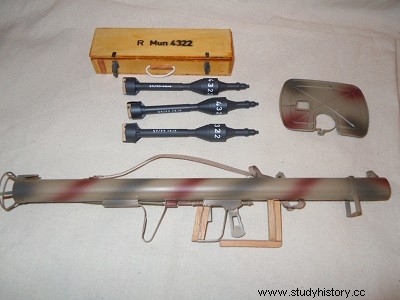
Features
RPzB 43
Caliber: 88 mm.
Length :1.63 m.
Weight:launcher, 9,200 kg;
rocket, 3.270 kg;
head , 0.650 kg.
Maximum capacity :150 m.
By 1943, the Germans had seized a large number of American 60 mm M1 bazookas, and their technicians quickly realized the simplicity and the low cost of manufacture of this weapon, advantages which they decided to exploit. for the benefit of their own country. They were not long in carrying out an equivalent material, which fired a rocket similar to that of Püppchen with the exception of its electrical firing. The first German launch vehicle, the 88mm Raketenpanzerbüchse 43 (RPzB) was a simple tube open at both ends. The shooter slung it over his shoulder and operated the control lever of a small electric generator. Releasing the trigger produced energy transmitted by wire to the rocket motor for firing. The RPzB also had basic pointing devices.
It was an immediate success. Since it fired a larger projectile than the bazooka, it had superior anti-tank capability, but its range was limited to around 150m. Another downside was that the rocket engine had not completed combustion when it exited the tube, requiring users to wear protective clothing and a gas mask to avoid burns. The flame of the rocket was dangerous up to a distance of 4 m behind the tube when fired, and it was accompanied by a cloud of dust and particles which revealed the position of the part, which increased the risks run by users of the RPzB 43.
The Germans then produced the RPzB 54, a model equipped with a protective shield which made it unnecessary to wear special clothing, and the RPzB 54/ 1, which fired a more sophisticated rocket but required the use of a shorter launch tube and whose range was slightly greater than 180 m. The RPzB 54 and RPzB 54/1 replaced the RPzB 43, which passed to reserve and second echelon formations.
The use of these weapons very quickly spread to all the different theaters of operations. The latest rockets could pierce up to 160 mm of armour, but they were only used at short
range, which required great mastery of the implementation against the enemy . The gun team usually consisted of two gunners, a gunner and a loader who introduced the rocket into the tube and connected the firing cords. It was necessary to let the tank approach within a good range, but a hit on target ensured its destruction. The only solution to RPzBs was to use sandbags,
tracked skids or double armor, and to have the armor accompanied by infantry.
